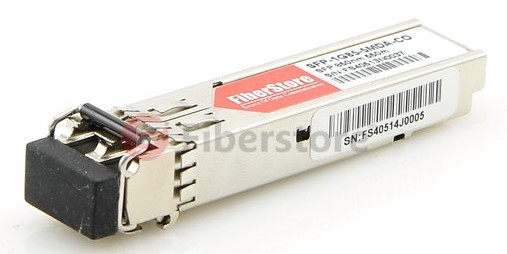Ever since the Gigabit Ethernet has been applied in the telecom industry, the supporting devices like SFP transceivers have enjoyed popularity among more and more places. But there are several types of SFP transceivers available on the market. Which one suits you better? This article will illustrate three types of SFP transceivers—1000BASE-T SFP, 1000BASE-SX SFP, and 1000BASE-LX/LH SFP. I hope readers can learn something at the end of this text.
SFP (Small Form-Factor Pluggable) transceiver is a compact, hot-swappable, input/output device that is used for both telecommunication and data communications applications. As a major component required for Gigabit Ethernet connectivity, SFP interfaces a network device motherboard to a fiber optic or copper networking cable. With so many types of SFP transceivers, users are supposed to select the appropriate one for each link to provide the required optical reach over the available optical fiber type (multimode fiber or single-mode fiber).
1000BASE-T SFP
1000BASE-T or IEEE 802.3ab is a standard of Gigabit Ethernet over copper wiring. It usually uses Category 5 cable or better for a maximum length of 100m. Complied with 1000BASE-T standard, 1000BASE-T SFP transceiver operates on standard Category 5 unshielded twisted-pair copper cabling for links of up to 100 meters in. These modules support 10 Megabit, 100 Megabit, and 1000 Megabit (1 Gigabit) auto-negotiation and auto-MDI/MDIX. This type of transceiver provides a cost-effective copper cabling solution for Gigabit Ethernet connectivity.
1000BASE-T or IEEE 802.3ab is a standard of Gigabit Ethernet over copper wiring. It usually uses Category 5 cable or better for a maximum length of 100m. Complied with 1000BASE-T standard, 1000BASE-T SFP transceiver operates on standard Category 5 unshielded twisted-pair copper cabling for links of up to 100 meters in. These modules support 10 Megabit, 100 Megabit, and 1000 Megabit (1 Gigabit) auto-negotiation and auto-MDI/MDIX. This type of transceiver provides a cost-effective copper cabling solution for Gigabit Ethernet connectivity.
1000BASE-SX SFP
1000BASE-SX is one of the IEEE802.3z standard made for the laser transceiver witch work on short wavelength multimode fiber (850mm). The standard specifies a distance capability between 220 meters (62.5/125 µm fiber) and 550 meters (50/125 µm fiber). Compatible with the IEEE 802.3z 1000BASE-SX standard, this 1000BASE-SX SFP module is used only for multimode fiber networks, and operates over either 50 microns multimode fiber links for a distance of up to 550 meters or over 62.5 microns Fiber Distributed Data Interface (FDDI)-grade multimode fiber for a distance up to 220 meters. Typical 1000BASE-SX transceivers like GLC-SX-MM-RGD and J4858B. These two modules are with DOM support and extended working temperature. This picture shows a 1000BASE-SX SFP.
1000BASE-SX is one of the IEEE802.3z standard made for the laser transceiver witch work on short wavelength multimode fiber (850mm). The standard specifies a distance capability between 220 meters (62.5/125 µm fiber) and 550 meters (50/125 µm fiber). Compatible with the IEEE 802.3z 1000BASE-SX standard, this 1000BASE-SX SFP module is used only for multimode fiber networks, and operates over either 50 microns multimode fiber links for a distance of up to 550 meters or over 62.5 microns Fiber Distributed Data Interface (FDDI)-grade multimode fiber for a distance up to 220 meters. Typical 1000BASE-SX transceivers like GLC-SX-MM-RGD and J4858B. These two modules are with DOM support and extended working temperature. This picture shows a 1000BASE-SX SFP.

1000BASE-LX/LH SFP
The 1000BASE-LX/LH (long wavelength/long haul) SFP is fully compatible with the IEEE 802.3z 1000BASE-LX standard. This SFP transceiver operates over standard single-mode fiber link for a distance of up to 10 kilometers and up to 550 meters over any multimode fiber. 1000BASE-LX/LH SFP transceivers transmitting in the 1300nm wavelength over multimode FDDI-grade OM1/OM2 fiber require mode conditioning patch cables. For example, GLC-LX-SM-RGD is Cisco 1000BASE-LX/LH SFP for both multimode and single-mode fibers. When used over legacy multimode fiber type, this transceiver should be coupled through a mode conditioning patch cable.
The 1000BASE-LX/LH (long wavelength/long haul) SFP is fully compatible with the IEEE 802.3z 1000BASE-LX standard. This SFP transceiver operates over standard single-mode fiber link for a distance of up to 10 kilometers and up to 550 meters over any multimode fiber. 1000BASE-LX/LH SFP transceivers transmitting in the 1300nm wavelength over multimode FDDI-grade OM1/OM2 fiber require mode conditioning patch cables. For example, GLC-LX-SM-RGD is Cisco 1000BASE-LX/LH SFP for both multimode and single-mode fibers. When used over legacy multimode fiber type, this transceiver should be coupled through a mode conditioning patch cable.
Conclusion
There is no doubt that select the right SFP is crucial for an infrastructure. This article has provided some detailed information about three basic types of SFP transceivers, which might be helpful to you. And don’t forget to take the transmission distance and compatibility into account. Fiberstore, a professional telecommunication manufacturer, offers a large variety of SFP transceivers like 1000BASE-SX SFP, 1000BASE-T SFP and 1000BASE-LX/LH SFP.
There is no doubt that select the right SFP is crucial for an infrastructure. This article has provided some detailed information about three basic types of SFP transceivers, which might be helpful to you. And don’t forget to take the transmission distance and compatibility into account. Fiberstore, a professional telecommunication manufacturer, offers a large variety of SFP transceivers like 1000BASE-SX SFP, 1000BASE-T SFP and 1000BASE-LX/LH SFP.
评论
发表评论